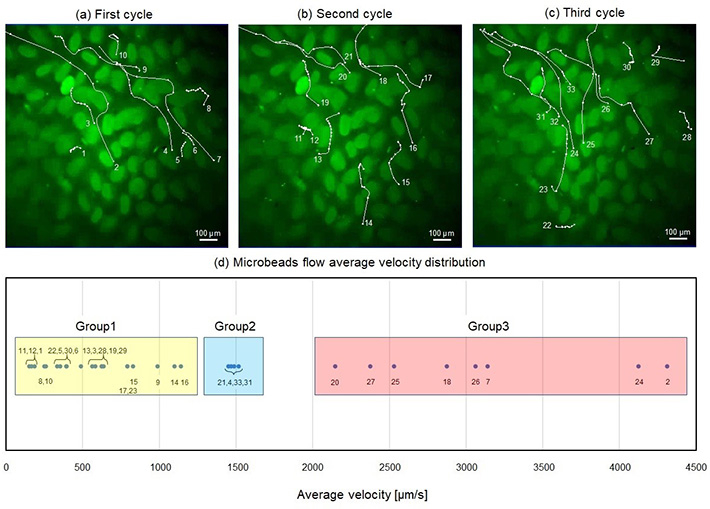A novel microfluidic device revealing diverse and dynamic flows in the small intestine has now been developed by scientists from Tokyo Tech. Their innovative experimental platform uses microscopic fluorescent beads as substitutes for gut bacteria in dissected small intestine sections, allowing one to visualize and quantitatively analyze the luminal dynamic flow in the tissues deformed by a pneumatic actuator.
Science is well aware of the important role that gut bacteria and their interactions with the gastrointestinal tract play in our overall health. Villi, tiny finger-like structures that line the inside of the small intestine (SI), are known to interact with the gut bacteria and trigger a protective immune response. Despite researching into the molecular mechanisms underlying these interactions, however, not much is known about the dynamics of liquid flow around the villi.
While computer simulations have aided such observations, the sheer complexity of the flow within the SI, also called "luminal flow," complicates these experiments. Further, the winding structure of the SI along with an irregular cross section, and intestinal motility, which plays a role in food transportation, retention, and mixing, makes things more challenging. Microscopic observation of luminal flow with sufficient spatiotemporal resolution is one viable alternative. However, the difficulty in maintaining and controlling motion in dissected SI tissues hinders systematic assessments of luminal flow mechanisms.
To remedy this situation, a team of scientists from Tokyo Institute of Technology, led by Associate Professor Tadashi Ishida and doctoral student Satoru Kuriu, have recently developed an innovative experimental platform to study the fine details of luminal flow around the villi. In their study, published in the journal Lab on a Chip on 22 May 2023, the scientists outline the design and application of a microfluidic system for observing the movement of microscopic fluorescent beads in a dissected SI section obtained from an animal model.
One of the key features of the proposed microfluidic device is the use of an array of air-driven balloon actuators (ABAs) pressed against the wall of the SI section from the outside. These small pneumatic components, when strategically inflated and deflated using an external pump, deform the SI sample in a way that generates dynamic flows around the villi (Figure 1).

Figure 1. Design of the proposed microfluidic device for observing dynamic flows in the intestine
By inflating and deflating the ABAs to deform the SI section, one can simulate the dynamic flows around the villi. At the same time, fluorescent microbeads can act as effective substitutes for gut bacteria.
Using this pneumatic-driven microfluidic intestinal channel device, the scientists conducted several experiments and recorded multiple videos of the movement of fluorescent beads, which served as substitutes of gut bacteria in the tissue. "Although the microbeads we used differ from real gut bacteria in terms of shape or the presence of certain proteins, we believe that they are simple and good substitutes, at least for the purposes of flow observation," explains Dr. Ishida. "Our proposed device can, therefore, be used to directly analyze physical flow within the SI."
The scientists tracked individual beads, both manually and with the help of specialized software that enabled them to conduct detailed quantitative analysis of the velocity and trajectory of the particles (Figure 2).

Figure 2. Quantitative analysis of the movement of fluorescent microbeads observed via the proposed microfluidic device
Tracking the movement of individual microbeads allows the identification of various types of unique flow around the villi.
With this approach, the team was able to identify various types of unique flow behaviors around the villi and observe the possible underlying mechanisms that give rise to them. "Our results suggest that the diverse flows observed in the SI for transportation, retention, and mixture are generated by its non-uniform shape and dynamic deformation," highlights Dr. Ishida. "For future studies, our analytical demonstration could serve as a cue for investigating the relationships between some unique subsets of intestinal cells or tight junctions and gut bacteria."
In summary, the findings of this study can serve to advance the understanding of the complex hydrodynamics in human digestive tracts. We hope this development will pave the way for new insights about our relationship with the ever-important microscopic gut hitchhikers.
Reference
Authors : |
Satoru Kuriu1,2,*, Naoyuki Yamamoto3, and Tadashi Ishida2,* |
Title : |
Development of a microfluidic device to observe dynamic flow around the villi generated by deformation of small intestinal tissue |
Journal : |
Lab on a Chip |
DOI : |
|
Affiliations : |
1Institute of Industrial Science, The University of Tokyo
2Department of Mechanical Engineering, School of Engineering, Tokyo Institute of Technology
3Department of Life Science and Technology, School of Life Science and Technology, Tokyo Institute of Technology
|
* Corresponding authors' emails: kurius@iis.u-tokyo.ac.jp, ishida.t.ai@m.titech.ac.jp
. Any information published on this site will be valid in relation to Science Tokyo.






